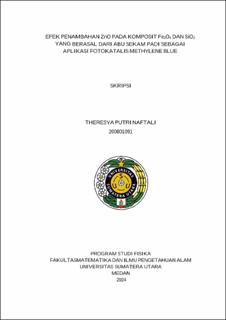| dc.description.abstract | Rice is highly sought after in Indonesia and plays an important role in the country's
economy. However, increased rice production also generates more waste, including
rice husks. Rice husks can be converted into silica (SiO2), which is useful in many
applications, especially as particles. This research characterizes Fe3O4/SiO2/ZnO
samples, focusing on the effect of ZnO addition on the structure, phase, and
physicochemical properties. It starts with drying rice husks in an oven at T = 100°C
for t = 150 minutes per 200 grams of rice husks. Then, the ash from the dried rice
husks is stored in a sterile container. After this stage is completed, the activation and
fabrication of SiO2 continue. The dried rice husks are divided into several parts in
containers, each weighing m = 250 grams, then put into a furnace. Samples that
have undergone the best furnace process at T = 950°C for t = 120 minutes are taken
to measure their weight, which is m = 55.65 grams. After measuring, the samples are
ground with a 200 mesh sieve for t = 60 minutes, then placed in a tightly closed
sterile container. Activated with the addition of ZnCl, m = 5.25 grams. 40 ml of
distilled water is added to the sample, then stirred using a magnetic stirrer for t = 1
hour at n = 50 RPM. This process is similarly conducted for mixing
Fe3O4/SiO2/ZnO. SEM-EDX analysis shows sample inhomogeneity with ZnO
dominance and strong bonding between Fe2O3 and SiO2. XRD identifies three crystal
phases: stishovite (tetragonal), magnetite (cubic), and wurtzite (hexagonal),
influenced by the presence of ZnO with Miller indices 100 and peak planes (100),
(110), (111), (200), (202), and (400). XRF testing shows variation in the sample
content, while UV-Vis analysis finds a linear relationship between absorbance and
Methylene blue concentration. This study provides insights into the potential
applications of this material in nanomaterial-based technology. Thus, this research
successfully produced the desired Fe3O4/SiO2/ZnO material through the activation
and fabrication process, which has broad potential applications in various fields. | en_US |


